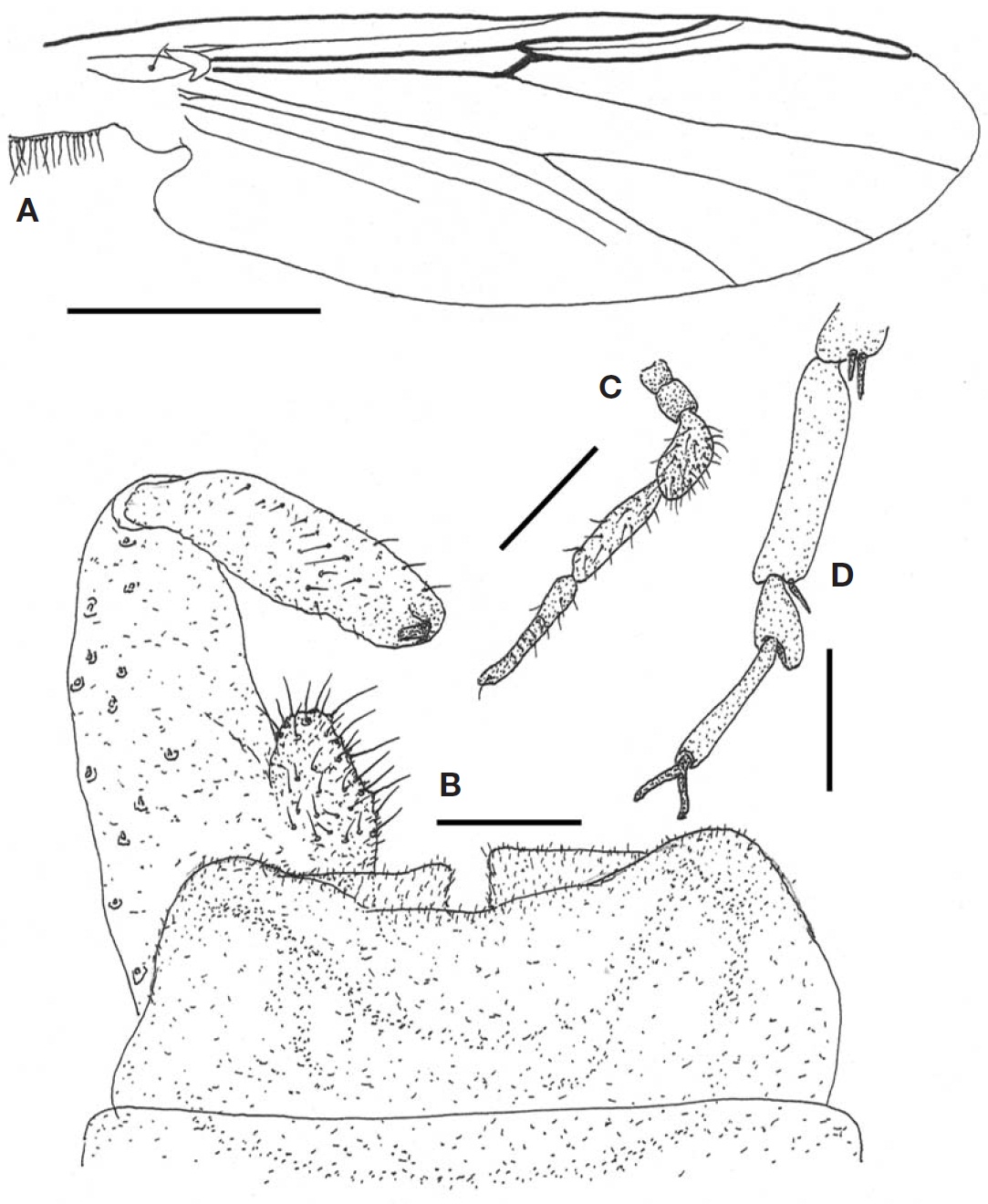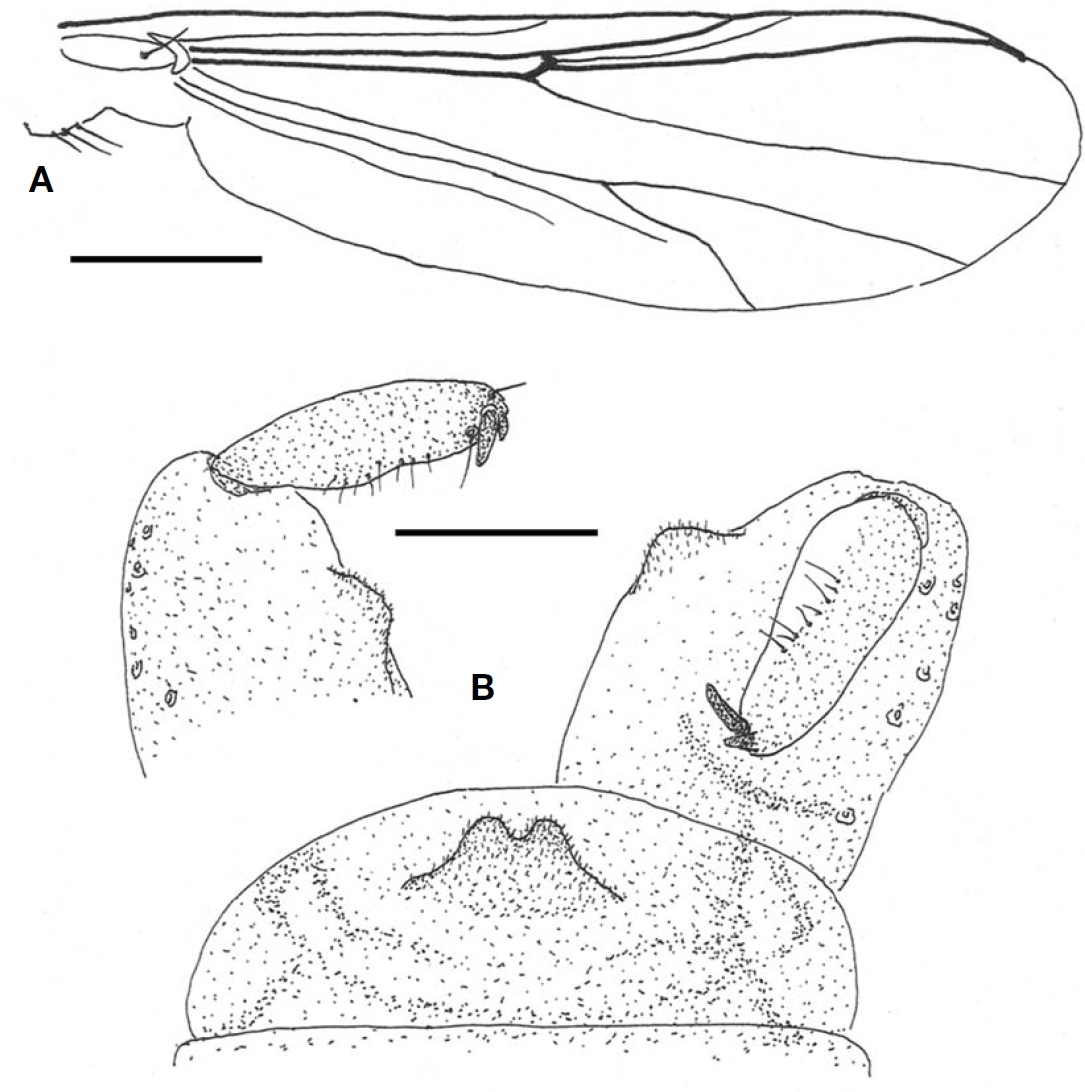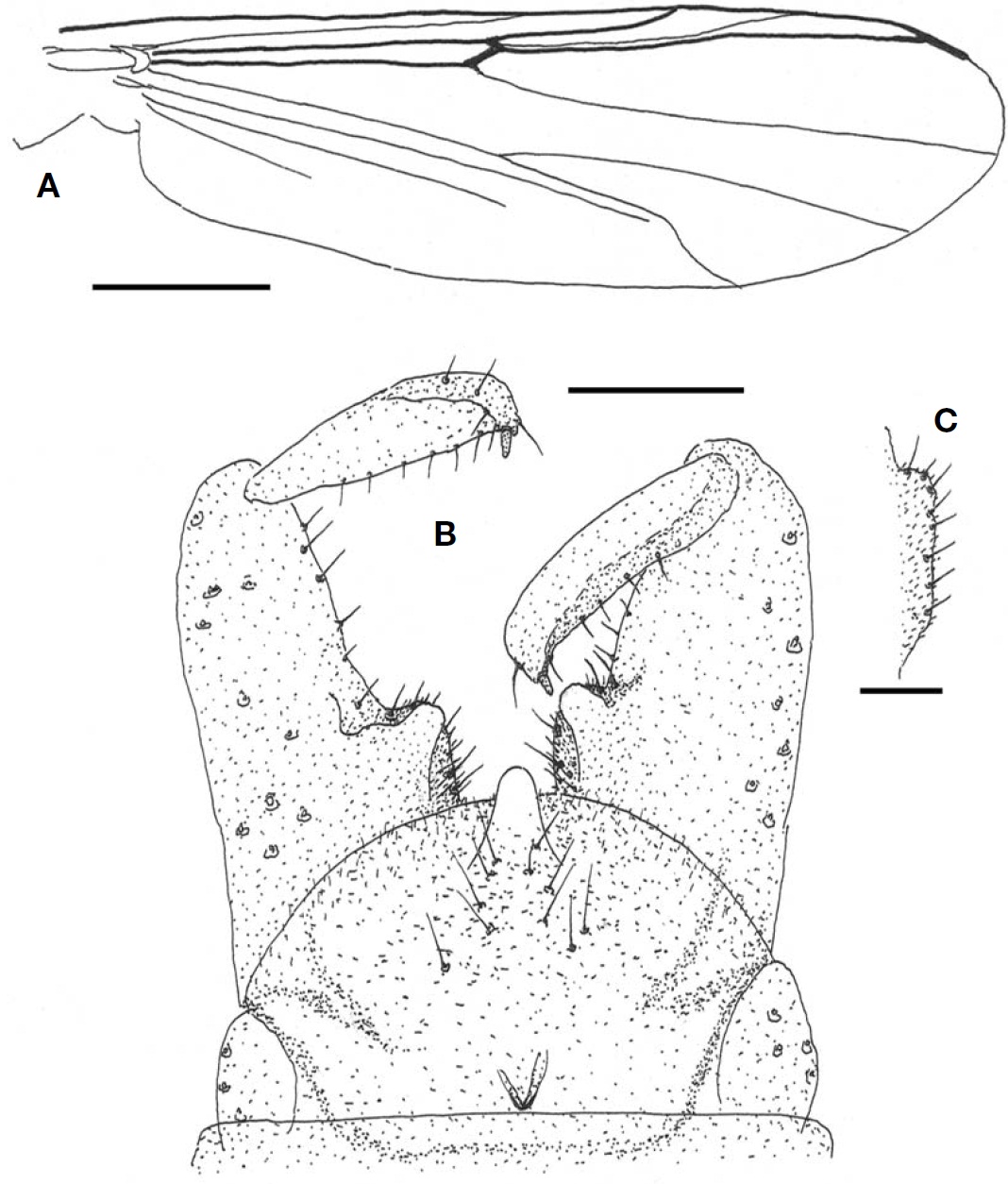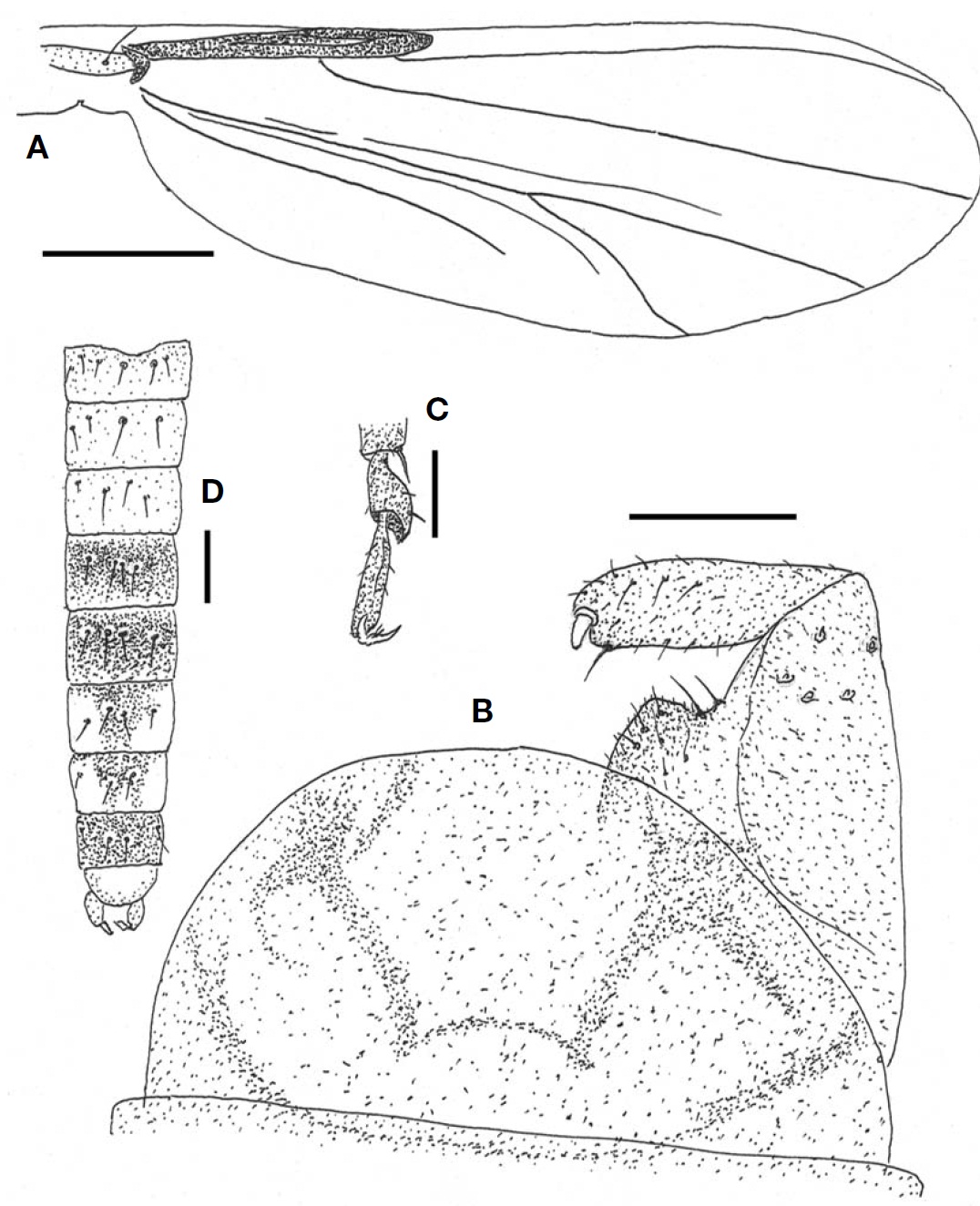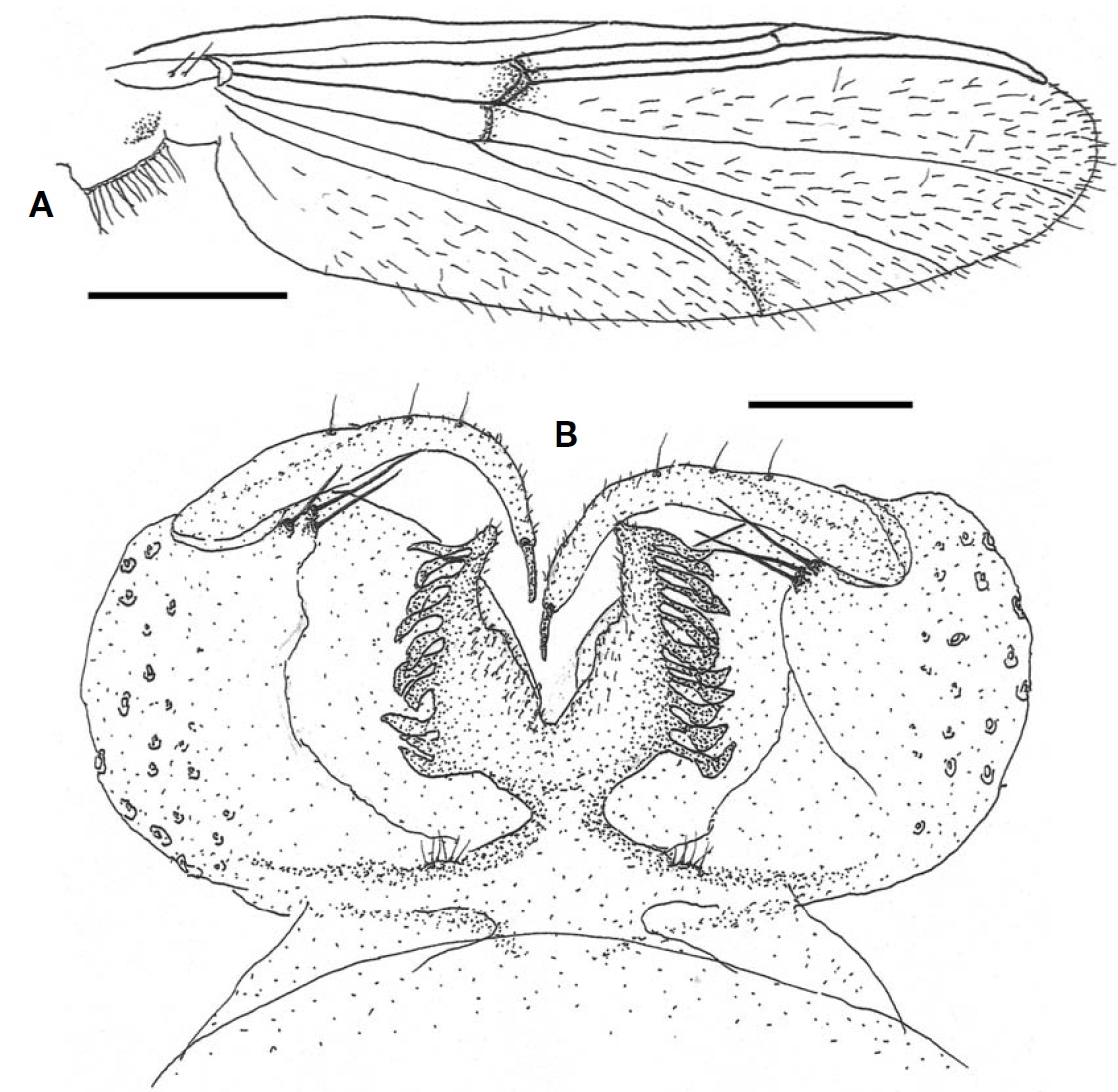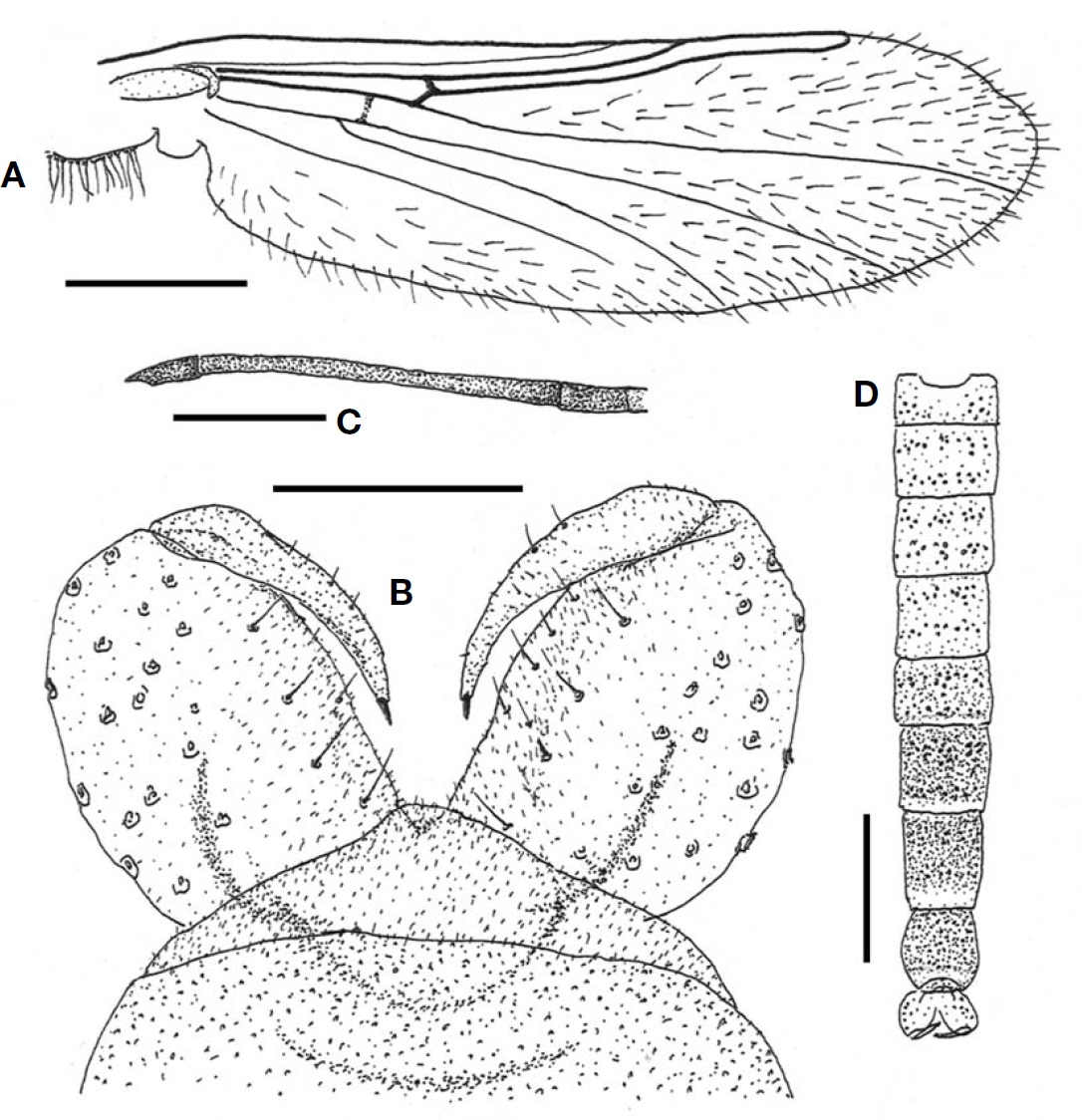



Non-biting midges (Diptera, Chironomidae) include a large number of species, whose larvae are found in almost all types of waters. Emerged in large numbers and attracted to elect-ric lights, they cause unpleasant living and play an important role in allergic diseases (Lee et al., 1995; Yong et al., 1999).
Total 1,113 adults were collected near Namdae Stream located in Muju-gun in 2008-2009. One new and eight newly recorded species of the genus
Adult chironomid collections were carried out near Namdae Stream located in Dangsan-ri, Muju-eup, Muju-gun, Jeol-labuk-do on September 2008 and in May and August 2009. Adults attracted to light sources of various buildings and ad-vertising signage of restaurants and stores. Namdae Stream runs through the western area of Muju-gun, and joins to the Keum River. The many restaurants are located along the stream in the vicinity of the 120 mm long Namdaecheon Bri-dge. Large numbers of non-biting midges and mayflies arise from the stream.
Aspirated adults were preserved in 75% ethanol, and later they were dissected under stereomicroscope using fine need-les to retrieve the antennae, head, wings, abdomen and hypo-pygium, and were mounted on polyvinyl alcohol medium.
Order Diptera
Family Chironomidae Macquart
Subfamily Orthocladiinae Edwards
Genus Caradiocladius Kieffer
1*Cardiocladius capusinus (Zetterstedt, 1850) (Fig.1 )
Material examined. 1♂ (R-CH-6448), Korea: Jeollabuk-do, Muju-gun, Muju-eup, Dangsan-ri, 5 Sep 2008, Jeong KY, Nam SH.
Diagnosis. Small to medium (wing length [WL] 1.5 mm), yellowish brown species. Anal tergite with two lobes locat-ed posteriorly at middle. Inner lobe of gonocoxite long, fin-ger-like, with numerous setae. Abdominal tergite brownish yellow, with a large and rectangular dark patch. Antennal ratio (AR) 1.31. Leg ratio (LR) 0.68.
Description (male). Head: Eye bare, not dorsomedially pro-duced. Antenna brown, with 13 segments; AR 1.31. Clypeus yellowish brown, with about 50 setae. Palp pale dark brown, with five segments: 36, 52, 114, 179, 173 μm (1 : 1.5 : 3.2 :5.0 : 5.4); 3rd segment unusually wider (114 μm long ×68μm wide) and many setae (Fig.1 C). Thorax: Yellowish-brown in ground color. Antepronotum well-developed, yel-lowish-brown. Scutum yellowish-brown, with vandike-brown vittae; about 20 minute, decumbent acrosticals; 17-19 erect dorsocentrals, arising from pale pits and 9 prealars each side. Scutellum brown, with about 30 setae. Postnotum dark brown. Halter pale yellow. Wing (Fig.1 A): WL 1.5 mm. Membrane bare. Costa not produced. R2+3 end near R1. R4+5 distal to M3+4. RM under FCu. Cu1 almost straight. Anal lobe deve-loped. Squama fringed. Brachiolum and arculus dark brown. Legs: Uniformly brown. Fore tibia with a sharp apical spur; mid tibia with 2 strong spurs, mid tarsi I-III with 2 short spurs; hind tibia with 2 strong spurs and several weak spurs, hind tarsi I-III with 2 short spurs. Tarsus IV shorter than tarsus V, and bilobed at tip (Fig.1 D). Pulvillus absent. LR 0.68. Abdomen: All tergite brownish-yellow, each with a large rectangular brown patch and numerous setae arising from small, pale pits. Hypopygium (Fig.1 B): Anal tergite with 2 lobes posteriorly at middle, without median and apical setae. Anal point absent. Inner lobe of gonocoxite rather long, finger-like, with numerous setae. Gonostylus with smoothly rounded tip, a ventrally directed megaseta.
Remarks.
Genus Lymnophyes Eaton
2*Lymnophyes parakitanaides sp. nov.
Material examined. Holotype, 1♂ (R-CH-6452), Korea: Jeollabuk-do, Muju-gun, Muju-eup, Dangsan-ri, 5 Sep 2008, Jeong KY, Nam SH. Paratype, 5♂♂ (R-Ch-6450, 6761, 6961, 6967, 6984), data as same as holotype.
Diagnosis. Dark brown to yellow-brown, small midges (WL 1.02 mm). 1-3 setae on each of epimeron II, preepisternum and posterior anepisternum II; lamellar setae on scutum ab-sent. Anal tergite prominentely produced posteriorly, with a pair of rather small lobes on middle. Gonocoxite large, with smoothly rounded inner lobe. AR 0.64. LR 0.56.
Description (male). Head: Eye reniform, bare. Two postocu-lars. Antenna dark brown, with 13 segments. AR 0.64. Palp pale dark brown, with 5 segments: 20, 23, 56, 46, 57 μm (1 :1.2 : 2.8 : 2.3 : 2.9). Clypeus brown, with 15 setae, uniserial.
Thorax: Dark brown in ground color. Antepronotum dark brown, moderately developed, lobe just separated, with 1 dorsal seta and 1 ventral seta. Scutum brown, vittae not dis-tinguishable; 8-9 long, erect dorsocentrals and 6-7 prealars each side. Scutellum dark brown, with 9 setae. Postnotum dark brown. 3 setae on epimeron II, 3 setae on preepister-num, and 1-2 posterior anepisterum II. Halter dark brown at tip. Wing (Fig.2 A): WL 1.02 mm. Membrane bare, coarsely dotted with microtrichiae. Costa well produced. R2+3 ending at middle between R1 and R4+5. FCu distal to RM. Cu1 bent at middle. Anal lobe not developed. Squama with 4 setae. Arculus pale, brachiolum pale with 1 seta. Legs: Uniformly yellowish brown. Fore tibia with a long apical spur; mid tibia with 2 spurs; hind tibia with 2 spurs and several comb spurs. Pulvillus absent. LR 0.56. Abdomen: Tergite I-IV pale brown and V-VII yellowish dark brown. Hypopygium (Fig.2 B): Anal tergite smoothly rounded distally, with a pair of dark brown lobes at middle. Gonocoxite large, with smoothly rounded inner lobe. Gonostylus parallel-sided, with a prominent megaseta and a smaller pseudospur at tip.
Etymology. The name
Remarks. This new species is similar to
several setae, and located on posterior margin of the tergite.
Genus Parakiefferiella Thienemann
1*Parakiefferiella mujuensis sp. nov.
Material examined. Holotype, 1♂ (R-CH-6945), Korea: Jeollabuk-do, Muju-gun, Muju-eup, Dangsan-ri, 22 May 2009, Jeong KY. Paratype, 2♂ ♂ (R-CH-6451, 6564), locality same as holotype, 15 Sep 2008, Jeong KY, Nam SH; 2♂ ♂ (R-CH-6834, 6872), same as holotype.
Diagnosis. Brownish-yellow, small to medium midges (WL 1.45 mm). Anal point rather short, pale, with smoothly round-ed tip. Gonocoxite long, rather slender, with 2 inner lobes:
dorsal one pale, bare, ventral one covered with microtrichia and short setae. AR 0.98. LR 0.54.
Description (male). Head: Eye reniform, bare. Antenna pale dark brown, with 13 segments. AR 0.98. Palp pale, with 5 segments: 29, 32, 71, 102, 171μm (1 : 1.1 : 2.5 : 3.5 : 5.9). Cly-peus brownish-yellow, with 10 setae. Thorax: Brownish-yellow in ground color. Antepronotum brownish-yellow, narrowed dorsally. Scutum brownish-yellow, with dark brown vittae; acrosticals absent. Scutellum brownish-yellow, with 2 setae. Postnotum dark brown. Wing (Fig.3 A): WL 1.45 mm. Membrane bare, transparent. Costa well produced. R2+3 run-nning close to R4+5. FCu distal to RM. Cu1 bent at middle. An reaching beyond FCu. Anal lobe moderately developed. Squama bare. Arculus pale, brachiolum pale with 1 seta.
Legs: All segments uniformly pale yellow. Fore tibia with an apical spur; mid tibia with 2 short, pale spurs; hind tibia with a long spur and 9-11 free comb spurs. Pulvullus absent. LR 0.54. Abdomen: All segments uniformly pale yellow.
Hypopygium (Fig.3 B): Anal tergite hemisphere distally, with 10-11 median setae. Apodemes pale, not well develop-ed (not clearly seen). Anal point pale, rather short, with smoo-thly rounded tip. Gonocoxite long, rather slender, with 2 go-nocoxite inner lobes: dorsal one pale and bare, ventral one covered with microtrichia and many short setae (Fig.3 C).Gonostylus slender, parallel-sided, with a pale, megaseta and 2 subapical setae.
Etymology. The new name refers to the place where this species was first collected.
Remarks. Two forms are observed in color of scutal vittae; one dark brown and the other brownish yellow which is not clearly distinguishable. Double lobes of gonocoxite of this new species are similar to those of
but differs in the ventral lobe, which is rectangular in the for-mer, whereas triangular in the later (Ree and Kim, 1981).
1*Genus Thienemanniella Kieffer
2*Thienemanniella vittata (Edwards, 1924)
Material examined. 5♂,♂ Korea: Jeollabuk-do, Muju-gun, Muju-eup, Dangsan-ri, 22 May 2009, Jeong KY. 5♂,♂ locality and collector same, 28 Aug 2009.
Diagnosis. Brownish-yellow, small midges (WL 0.98 mm). Antenna pale brown, with 12 segments. Costa fused with R1, forming thick clavus, ending about 1/3 of wing length.
R4+5 not fused with R1, reaching apex of wing. Anal point ab-sent. Inner lobe of gonocoxite somewhat triangular, covered with microtrichia. AR 0.58. LR 0.91.
Description (male). Head: Eye reniform, pubescent. Post-orbitals absent. Clypeus narrow, with 10 setae arranged bise-rially. Antenna pale brown, with 12 segments. AR 0.58. Palp pale, with 4 segments: 14, 41, 54, 99 μm (1 : 2.9 : 3.9 : 7.1).
Thorax: Brownish-yellow in ground color. Antepronotum brownish-yellow, narrowed dorsally, widely separated. Scu-tum brownish-yellow, with dark brown vittae; acrosticals ab-sent, 7 dorsocentrals and 3 prealars each side. Scutellum dark brown, with 2 setae. Postnotum dark brown. Wing (Fig.4A): WL 0.98 mm. Membrane bare, transparent. Costa fused with R1, forming thick clavus, ending about 1/3 of wing length.R4+5 not fused with R1, reaching apex of wing. Cu1 slight-ly bent. FCu far distal to RM. Anal lobe poorly developed.Squama bare. All veins bare. Arculus dark brown, brachio-lum pale with 1 seta. Legs: All segments uniformly pale.
Fore tibia with a long apical spur; mid tibia with 2 small spurs; hind tibia with 2 spurs and several comb spurs. Tar-sus IV somewhat cardiform and shorter than tarsus V (Fig.4C). Pulvillus absent. LR 0.91. Abdomen (Fig.4 D): Tergite I-III brownish pale yellow; tergite IV, V, VIII dark brown; tergite VI ,VII pale with dark brown patch on middle. Hypo-pygium (Fig.4 B): Anal tergite comparatively large, hemi-sphere distally; apodemes strongly sclerotized. Anal point absent. Inner lobe of gonocoxite somewhat triangular, cover-ed with microtrichia and several small setae. Gonostylus parallel-sided with a terminal spur.
Remarks. The genus
Subfamily Tanypodinae Thienemann and Zavrel
1*Genus Conchapelopia, Fittkau
2*Conchapelopia pallidula (Meigen, 1818)
Material examined. 2♂ ♂ (R-CH-6546, 6596), Korea: Jeol-labuk-do, Muju-gun, Muju-eup, Dangsan-ri, 22 May 2009, Jeong KY.
Diagnosis. Pale yellow, medium-sized species (WL 2.2 mm). Wing membrane densely covered with macrotrichia, without markings except around RM. MCu distal to FCu. Anal tergite pale, very small in size. Gonocoxite large, mussel-shell in form, with 3 strong setae on proximal base of gonostylus. Median volsella well developed, with a row of spoon shap-ed processes outerlaterally. Gonostylus long, slender, curv-ed at middle. AR 1.54. LR 0.82.
Description (male). Head: Redish yellow in ground color. Eye bare, dorsomedially extended. 12-13 postoculars. Anten-na pale brown, with 14 segments; last segments much shor-ter than penultimate one. AR (last 2 segments/1-12 segments) 1.54. Clypeus brownish yellow, oval in shape, with about 30 setae. Palp pale, with 4 segments: 112, 166, 216, 288 μm (1 :1.5 : 1.9 : 2.6). Thorax: Pale yellow in ground color. Antepro-notum pale, narrowed dorsally, lobe separated. Scutum pale yellow, anterior half of dorsocentral and lateral vittae dark brown. Scutellum pale, with 35-40 setae. Postnotum brownish yellow. Wing (Fig.5 A): WL 2.2 mm. Membrane densely covered with macrotrichia; Only area of RM slightly darker(brownish yellow), no other dark markings. Costa not pro-duced. R2+3 forked. R4+5 ending distal to M3+4. MCu just distal to FCu. An ending beyond FCu. Anal lobe moderate-ly developed. Squama with many setae. Arculus pale, brachi- olum pale with 2 setae. Legs: All segments uniformly pale yellow. Fore tibia with a short, dark spur; mid tibia with 2 spurs; hind tibia with a long spur, a short spur and free comb 7-8 free spurs. Pulvillus absent. LR 0.82. Abdomen: Ter-gite I-VI pale yellow, VII-VIII brown. Hypopygium (Fig.5B): Anal tergite pale, extremely small. Gonocoxite large, somewhat flattened and round (mussel-shell in form), with 3 strong setae just proximal to basal portion of gonostylus. Me-dian volsella well developed, with a row of spoon shaped pro-cesses outerlaterally. Gonostylus long, slender, curved at mid-dle, with a dark brown megaseta.
Remarks. The most prominent character of this species is the spoon-shaped processes of median volsella along outerla-teral margin. Pinder (1978) described that the processes of gonocoxite lobe are expanded subapically so that they look like somewhat spoon-like in shape, whereas those of our specimens look like more distinct spoon-like in shape.
1*Genus Nilotanypus Kieffer
2*Nilotanypus dubius (Meigen, 1818)
Material examined. 3♂,♂ Korea: Jeollabuk-do, Muju-gun, Muju-eup, Dangsan-ri, 28 Aug 2009, Jeong KY.
Diagnosis. Dark brown, rather small midges (WL 1.1 mm). Eye hairy, with well developed dorsomedial extension. Wing membrane thickly covered with macrotrichia. Costa relative-ly short (about 3/4 of wing length). R2+3 absent. RM at basal 1/4 of wing length. MCu proximal to RM. Anal tergite small, without any setae. Gonocoxite large, oval in shape,without inner lobe. AR 0.65. LR 0.78.
Description (male). Head: Eye hairy, dorsomedial projec-tion well developed. Antenna dark brown, with 14 segments:last segment short (44.6 μm) (Fig.6 C). AR (13-14 segments/1-12 segments) 0.65. Palp pale yellow, with 4 segments: 29,76, 108, 90 μm (1 : 2.6 : 3.7 : 3.1). Clypeus brownish yellow, with 16 segments. Thorax: Dark brown in ground color. Antepronotum dark brown, sharply narrowed dorsally, with 5-6 setae ventrally. Scutum dark brown, vittae not clearly de-fined, 15-16 dorsocentrals and 9 prealars each side. Scutel-lum dark brown, with 8 long and many short scutellars. Post-notum dark brown. Wing (Fig.6 A): WL 1.1 mm. Membrane thickly covered with macrotrichia. Costa relatively short (about 3/4 of wing length), not produced. R2+3 absent. RM located at about basal 1/4 of wing length. MCu proximal to RM, and distal to FCu. R4+5 proximal to M3+4. Cu1 long, almost straight. Anal lobe moderately developed. Squama with many setae. Arculus dark brown, brachiolum pale dark brown with 2 setae. Legs: Femurs pale dark brown. Tibiae pale yellow (fore tibia darker). All tarsi pale. Fore and mid tibiae with a long, pale spur; hind tibia with a long spur and 5 free comb spurs. Pulvillus absent. LR 0.78. Abdomen (Fig.6 D): Tergite I-IV pale dark brown; tergite V-VIII dark brown (VI with narrow distal pale band, and VII with wider distal pale band). Hypopygium (Fig.6 B): Tergite IX (anal tergite) very small, without any setae. Phallapodeme strong,most part located in gonocoxite. Transverse sternapodeme strong. Gonocoxite large, oval in shape, without inner lobe.Gonostylus narrow, sharply tapered apically, slightly bent,with a rather small megaseta.
Remarks. This is the frist description of the genus
Korean name: 1* 황갈마디깔따구(신칭), 2*아기볼물깔따구(신칭)
Korean name: 1* 무주숲깔따구(신칭)
Korean name: 1*몽당깔따구속(신칭), 2*좀몽당깔따구(신칭)
Korean name: 1*민다리깔따구속(신칭), 2*수푼민다리깔따구(신칭)
Korean name: 1*횡맥늪깔따구(신칭), 2*흰다리횡맥늪깔따구(신칭)
